Australia Defence during the 20th Century
John Curtin fell short at our darkest hour
Sure, if the ALP needs saints, let it beatify John Curtin. But if the government thinks his insular mindset exemplifies what the times demand, Australia is in for a rude awakening.
Article from Henry Ergas and Alex McDermott
Weekend Australian July 19 2025
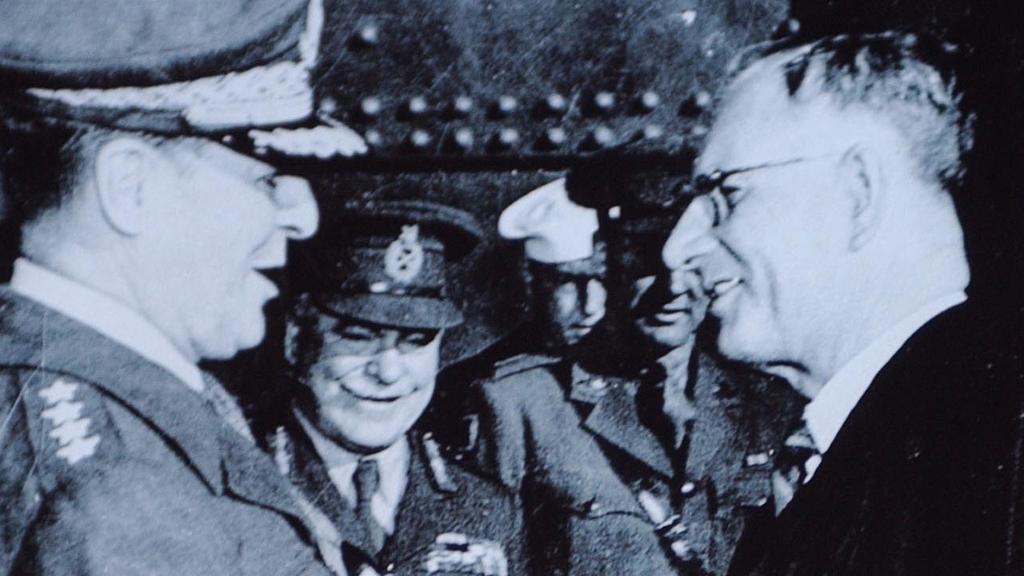
| |
US General Douglas MacArthur (left) meets Australian prime minister John Curtin in Canberra in 1942. Picture: Tony Phillips/AAP | |
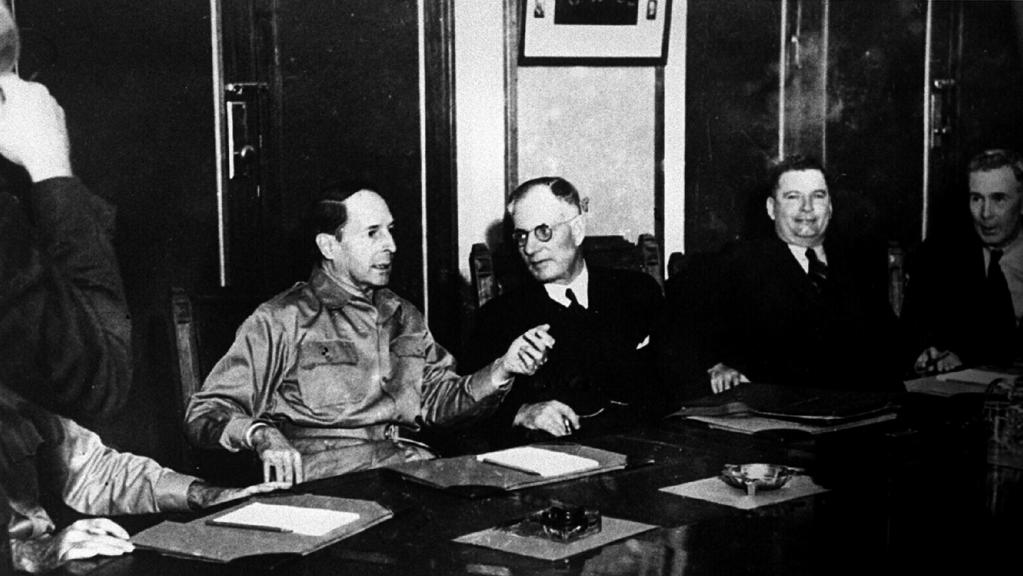
| |
Historic meeting of Labor wartime prime minister John Curtin with General Douglas Macarthur at Advisory War Council, Melbourne 1942.
|
|
Whatever Washington may make of the John Curtin Oration Anthony Albanese gave a few days before setting off for China, there is no doubt that it warmed hearts in Beijing. Yet the fundamental importance of that oration does not lie solely in its immediate message; rather, it lies in the far broader question of how Australia should manage its alliances at a time of sweeping geopolitical change.
Viewed in that perspective, the thrust of Albanese’s oration boils down to this: great prime ministers, such as Curtin, push back against their nation’s most important allies and insist on doing what they perceive as being in Australia’s interests instead. That, the oration contends, is exactly what Curtin did when he repulsed British and American requests to route returning AIF soldiers to Burma during World War II, justly earning his heroic stature in the national consciousness ever after.
However, the historical reality is far more complex; indeed, it is difficult to think of a worse example than the Curtin government of how Australia can ensure its sovereignty while securing the benefits alliances provide. As we struggle with those issues today, that government stands as an exemplary failure – a failure that contrasts sharply with the lessons of our considerable, if hard-won, successes. Far from retaining sovereignty, no prime minister in Australian history capitulated more entirely than Curtin did when he handed total oversight of war strategy to US general Douglas MacArthur shortly after his arrival in Australia in March 1942.
For Curtin, the bulk of whose political life had been as a socialist radical, deeply committed to pacificism and to isolationism, the benefit of giving up control was plainly evident. Granting MacArthur unfettered authority, Curtin was content to let American conscripts fight crucial northern battles while insisting Australian conscripts remain largely in home territory. As John Hirst put it in a brilliant, recently republished Black Inc essay on Curtin’s wartime prime ministership that set the record straight, “Curtin was never happier than when it seemed Australia’s role in the war was to grow food and make munitions.”
It is true that small powers have limited influence over great allies. Yet Curtin did have considerable leverage, with MacArthur initially reliant on Australian troops to provide the bulk of his fighting forces in the South West Pacific zone. “What is disturbing in Curtin”, writes Hirst, is that despite his leverage “he made no attempt to test the boundaries”, instead remaining “absolutely in thrall to MacArthur” until his death. Curtin’s replacement, Ben Chifley, once in office, immediately rebuked MacArthur for treating Australia as supine and independently planned Australia’s role in Japan’s post-war occupation. It was then, Hirst concludes, that “you feel that Australia had acquired a government again”.
Instead of beatifying Curtin, Albanese would therefore be far better served by studying other Australian prime ministers who responded with decisive authority during moments of dramatic geostrategic shift – most signally Alfred Deakin and Robert Menzies, but also foundational Labor hero Andrew Fisher.
Australia’s strategic isolation became glaringly apparent after the Battle of Tsushima in May 1905 when Japan wiped out Imperial Russia’s Baltic fleet. During the War, Russia had to send their Baltic Fleet to reinforce their Pacific Fleet via the English Channel, the Suez Canal and Indian Ocean. However the larger ships had to go around Africa which took more than 6 months and 18,000 miles. Click here to see this map. The Russians lost the ensuing battle and the war.
Britain had struck an alliance with Japan in 1902 that enabled Britain to reduce its naval presence in the Pacific and concentrate them in the North Sea, where they could deal with the rising threat of the German navy. Japan’s victory at Tsushima eliminated its own sole remaining rival for Pacific supremacy.
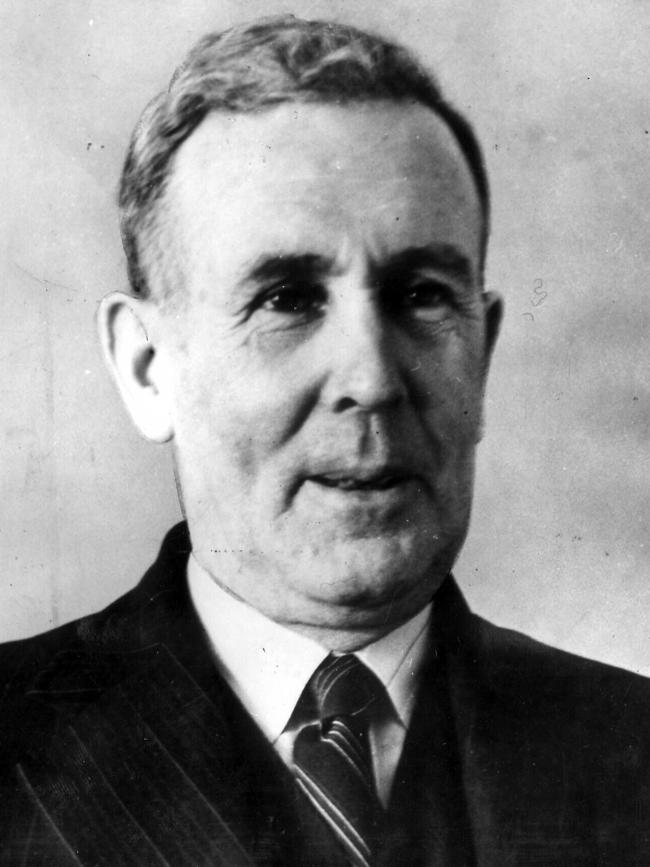
| |
Ben Chifley |
| 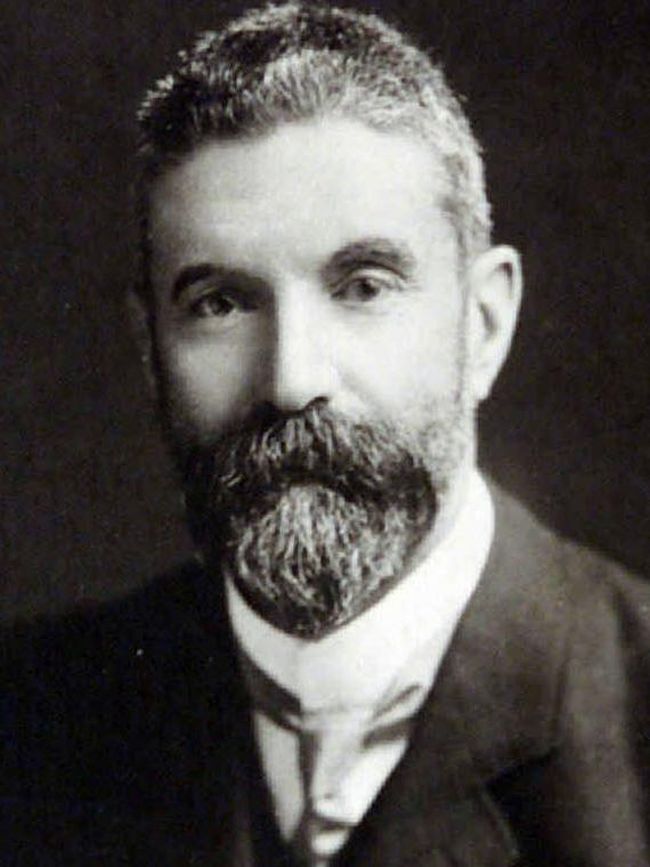
| |
Alfred Deakin |
| |
In an interview given to Melbourne’s Herald in the days after Tsushima, Deakin laid out the new geostrategic facts Australia had to face.
Britain’s unquestioned supremacy of the world’s oceans, which had ensured Australian protection from the threat of hostile military incursions since the Napoleonic Wars, was a thing of the past. Now Australia was within immediate striking distance of potential enemies and no longer could assume the comforts of distance’s isolation: “Japan at her headquarters is next door, while the Mother Country is many streets away, and connected by long lines of communication.” Regardless of whether Japan or Russia had prevailed, the decisive victory left Australia exposed.
Australians, lulled by many decades of total strategic security, had to wake up to the risks and responsibilities “that we have not realised in Australia in all the long period of peace”. “When we will be attacked,” Deakin grimly warned, “it will not be with kid gloves, or after convenient notice, but it will be when and where we least desire it, and with remorseless fury.” In order that Australians “may continue to enjoy the blessings of peace, the Commonwealth must be prepared to spend more liberally than it has ever done on its defence and defence forces”.
Returning from the 1907 Imperial Conference without having secured a strengthened British Pacific commitment, Deakin unveiled a new defence policy that foreign policy doyen Neville Meaney has described as “revolutionary”. An independent Australian navy was to be established, the army reorganised and universal compulsory military service introduced to ensure “a defence of the people, for the people, by the people”. These initiatives defied imperial advice, as did Deakin’s audacious invitation to US president Theodore Roosevelt’s Great White Fleet.
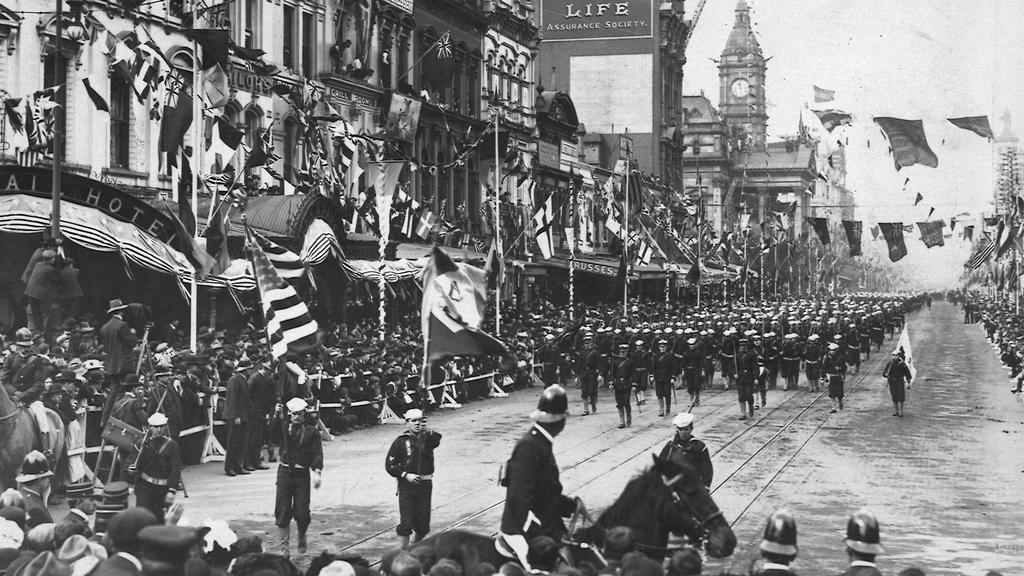
| |
US Navy marching in Swanston St on a visit to Melbourne in 1908.
| |
The US chief fleet, the only naval force capable of countering Japan’s Pacific penetration, was concentrated in the Atlantic. But with Japanese-American “war scares” proliferating, Roosevelt instructed his navy to transfer to the Pacific and embark on a world tour that would demonstrate its potency. While the ships were painted white to signal peaceful intent, their presence undeniably demonstrated the emergence of an Indo-Pacific power with significant regional claims of its own.
Whitehall feared that Deakin’s invitation indicated that Australia wished to leave Britain’s side for the US. But Deakin was far from wanting to jettison Britain, which he continued to view as an indispensable component of Australia’s system of alliances. Rather, he had simply concluded that in the face of mounting threats, two great and powerful friends, each sharing Australia’s core values, were better than one. The visit of the US fleet was not just an exercise in alliance management; it was a vital part of Deakin’s project of awakening a previously apathetic electorate to the need for defence preparedness.
A half-million people gathered in Sydney and Melbourne in August and September 1908 to greet the fleet, demonstrating an enthusiasm that verged on Federation-era Beatlemania. Banquets, processions, street illuminations, ceremonial arches, bunting and a sea of American, British and Australian flags generated waves of public euphoria that exceeded anything else in Australian history. The fleet’s reception easily dwarfed the celebrations that had inaugurated the commonwealth in 1901. Admiral Charles Sperry reported back to Roosevelt that their “sustained enthusiasm has not been equalled in our experience”.
But beneath the constant references to “blood ties” and “kin”, the real reason for the intense fervour stood out starkly: the sudden, acute sense of geostrategic isolation in the Pacific, now dominated by the potentially hostile fleet of an expansionist empire. With the public and all the major political parties persuaded, it fell to Labor leader Fisher, long an advocate of an Australian navy, to carry through Deakin’s pledge.
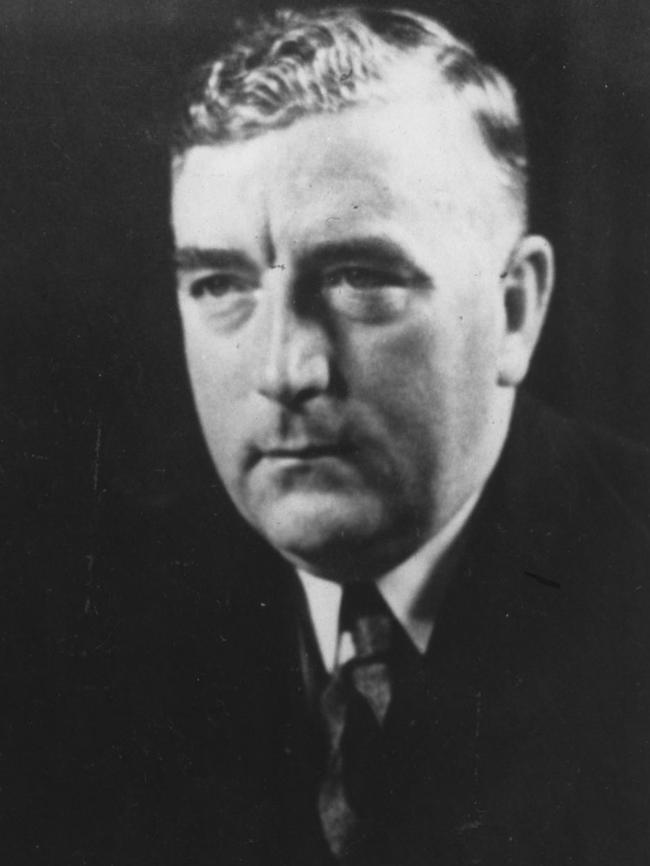
| |
Robert Menzies |
| 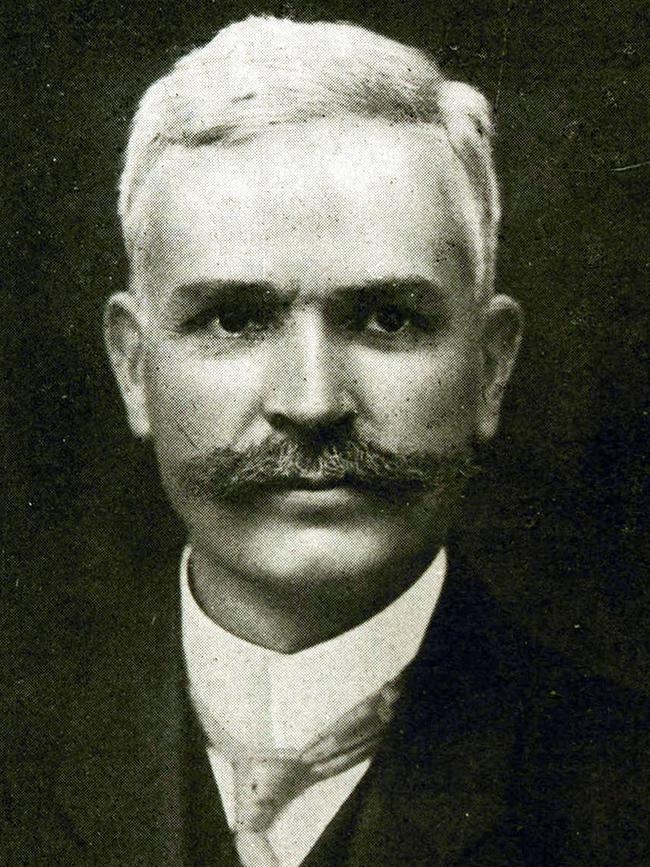
| |
Andrew Fisher |
| |
Unlike Curtin, who opposed necessary increases in defence expenditure in the lead-up to World War II, Fisher, his defence minister George Pearce and deputy leader Billy Hughes ensured that by 1914 Australia’s armed forces bore comparison with the world’s most advanced – a fact that underpinned their performance on the field of battle during the four hard years of World War I.
Deakin’s revolution in strategic outlook yielded enduring results, even though it took more than 40 years after the Great White Fleet’s Australian tour before a formal security alliance was cemented under the ANZUS Agreement of 1951. More than anything it highlighted, even as the recently formed commonwealth was taking its first steps, Australia’s need to strategically walk and chew gum at the same time: alliances and a substantive, credible commitment to the nation’s own military capacity, it showed, were not an either/or option; they marched, instead, hand-in-hand.
The same issues arose when prime minister Robert Menzies faced a strategic crisis of his own in 1963. In January that year, Indonesia’s authoritarian leader president Sukarno announced the Konfrontasi, an aggressive military confrontation with newly established Malaysia, a nation Sukarno declared a neo-colonial plot. Australia, a Malaysian ally that already had sent troops to its aid during the Malayan Emergency in the 1950s, was involved not solely because of regional alliance but because of direct territorial threat. Konfrontasi forces projected north to Malaysia could just as easily be pointed immediately south towards Australia, including Papua and New Guinea.
In this situation Australian allies were little help. Britain was committed to Malaysia but its global reach was flagging. The US was playing a larger Cold War game and refused to oppose Indonesia, which it hoped to woo away from Soviet and Chinese support.
Australia, whose defence posture for more than a decade had been entirely forward, built to involve itself with allied conflicts in the wider region, suddenly found it had to think again.
Menzies’ response was a masterclass in political leadership. On May 22, 1963, he announced to parliament a momentous overhaul of Australian defence forces. Previous defence forces had been designed to integrate with allies in repulsing enemies as far away from Australian shores as possible. That strategy had safeguarded Australia’s interests but, said Menzies, “as international strategic considerations change, so we must be ready to change our own defence arrangements … We have made our review in the light of our treaty arrangements, but particularly in reference to the security of our own country, and of the territories of Papua and New Guinea.” The government, Menzies declared, would now acquire “a capacity for independent action”.

| |
Australian soldiers during World War II at Milne Bay, New Guinea.
| |
This required a dramatic increase in defence expenditure, which effectively doubled, allowing for the purchase of significant new weaponry from Britain (Oberon-class submarines) and the US (F-111 strike aircraft). At the same time, the reintroduction of conscription enabled the army to double in size. Menzies directly addressed an immediate strategic threat no great ally would or could effectively assist against.
Yet what followed confirmed Menzies’ statecraft. While greatly reinforcing Australia’s own defences, he intensified his efforts to engage the US in Asia-Pacific security. His government’s proactive encouragement of American commitment to South Vietnam – where Menzies was, in John Howard’s words, “an enthusiastic barracker” rather than a passive bystander or obedient suppliant – was an act of strategic alliance-building even more than it was a commitment to counter communist aggression.
Menzies’ leadership in those crucial years, Andrew Carr and Peter Dean argue in the forthcoming Melbourne University Press publication The Menzies Legacy, established a Defence of Australia doctrine that articulated the ADF’s primary focus as the immediate defence of Australian territory in the context of a wider, heavily cultivated, alliance relationship. That doctrine remained our defence policy’s core principle for decades.
But as the 2023 Defence Strategic Review emphasised, the dramatic upsurge in China’s overwhelmingly asymmetric offensive threat capabilities imposes a reconsideration of its substance and implementation. Yet while circumstances have changed, any reconsideration must be informed by the realities that emerge from our now more than century old experience in managing alliances.
At the heart of those realities is the simple fact that alliances are not like houses, something to construct and then simply live in. They are relationships whose endurance can be assured only by constant attention and cultivation, based on an acute awareness of the parties’ positions, priorities and concerns. Central, in that respect, is a demonstrated willingness to bear one’s share of the load – as Deakin, Fisher and Menzies were clearly willing to do.
There are, for sure, times when the advantages to our larger partner of pursuing a mutually beneficial course of action are so great that it is willing to take on a disproportionate burden. In World War II, for example, the overwhelming importance to the US of defeating Japan meant it could readily put up with Curtin’s hesitations about the regional scope of Australia’s commitment. But even putting aside the high price Australia paid, in terms of sacrificed sovereignty, for Curtin’s hesitations, history is littered with instances in which the quality of alliances – and ultimately their persistence – has fallen victim to the resentments caused by perceived free-riding.
Moreover, the greater the capabilities Australia brings to the table, the greater the say we can legitimately claim and reasonably expect about critical decisions. And, crucially, the greater too are the options we have if and when the alliance falls short. In that sense, a willingness to bear, and be seen to bear, Australia’s fair share of the costs is a double insurance policy: it helps strengthen the alliance, with all the protection it brings; and it ensures we are not left entirely bereft should the alliance falter or collapse.
That is why Deakin and Menzies responded so positively to the prompts they received from alliance partners about the need to increase Australia’s defence preparedness: from Britain in Deakin’s case, from the US in Menzies’. Unlike Curtin, they recognised that accepting those prompts did not jeopardise Australia’s sovereignty; on the contrary, it placed that sovereignty on a surer footing.
But bearing the load is not merely a question of resource commitment. It is also a matter of taking the views and interests of allies seriously into account, in the process giving due weight to the importance of preserving the confidence and respect of one’s alliance partners.
No one understood that better than Winston Churchill, a favourite bete noir in Labor mythology. In early 1942, as Japan’s advance posed an ever-greater threat, Churchill suggested to Curtin that Singapore be evacuated and its Allied troops – including an Australian division – be redeployed. However, with Curtin having momentarily vanished from the scene as he dealt with one of his recurring physical and nervous breakdowns, Canberra responded that such an act would be an “inexcusable betrayal.” Against his better strategic judgment, Churchill acquiesced.
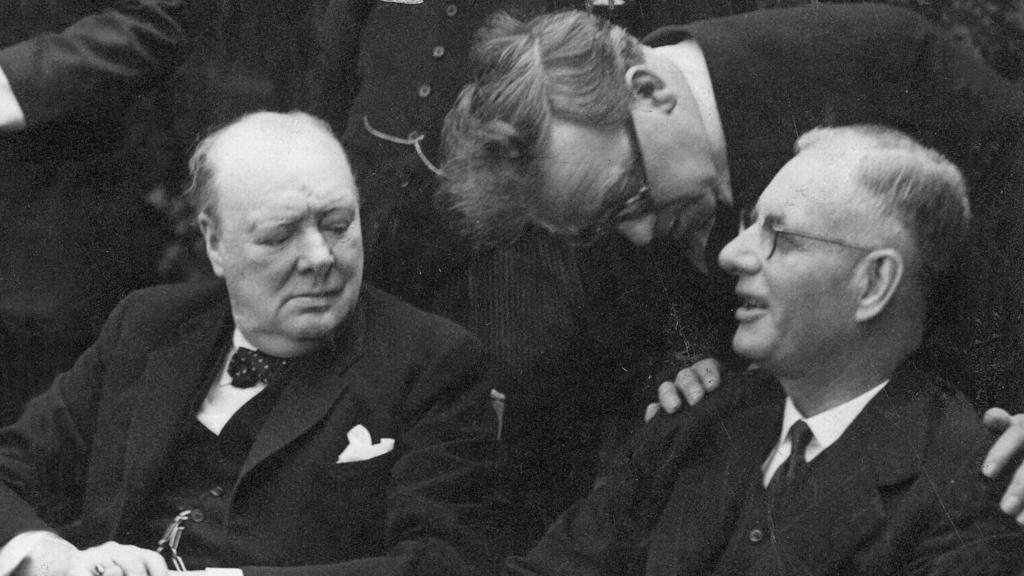
| |
Curtin with British politician prime minister Winston Churchill and British politician Herbert Morrison in 1944.
| |
The ignominious outcome – which should forever tarnish Curtin’s reputation – was the fall of Singapore and the devastating loss of 15,000 Australians from the 8th AIF Division and 80,000 British and Commonwealth soldiers.
Churchill put the needs of his alliance relationship above what he thought “a purely military decision should have been”. He sought to reassure an already thoroughly alarmed ALP government and solidify its commitment to the war effort, even though he was rightly convinced the Australian position was militarily unwise.
The contrast with Curtin’s conduct in refusing to redeploy Australian troops to Burma could not be starker. Those troops were intended to protect the allies’ supply routes to China, where most of Japan’s army continued to grapple with Chiang Kai-shek’s forces, significantly slowing Japan’s southward momentum. But Curtin’s instincts were, as they had been for years, strictly insular and parochial, leaving the overall impression that he really wasn’t up to the scale and strain of the job – and notably to the job of maturely managing an alliance.
Last but not least, sustaining an alliance requires the courage to bear political costs at home, when decisions that are controversial domestically need to be taken to keep the alliance fully intact.
Menzies repeatedly displayed that courage. He had already shown the importance he placed on alliances during the Suez crisis when, at Britain’s request, he agreed to undertake the thankless task of attempting a mediation with Egypt. Years later, when he was asked point blank “why he had let himself be the ‘fall guy’ over Suez”, his answer was simple: “When your friends are in great difficulty and ask for help, you don’t let them down”, even if responding to their request was likely to cause political grief at home.
The same willingness to bear political costs for the sake of strengthening Australia’s domestic and international security was evident when he proposed the reintroduction of conscription in 1964. “There comes a time in the life of any government where it just has to make decisions in the best interests of the country even if they believe they are committing political suicide,” Menzies told colleagues.
In short, effectively managing the alliances crucial to Australia’s security presents an immense political and intellectual challenge. This task is complicated by what one of us calls “Gallipoli syndrome”, a pervasive belief on Australia’s left (and beyond) that all alliances are destined to repeat supposed British ineptitude at Gallipoli or betrayal at Singapore. It’s also driven by an attitude of self-entitlement – what Hirst described as a quasi-colonial assumption that we are so valuable and cherished we shall never be left to fend for ourselves, and that even adolescent tantrums won’t endanger an alliance.
But it is a fact of life that the US is becoming more selective in its alliance relationships, and even more inclined to conclude that allies, rather than being force multipliers, are an unnecessary hindrance. Its own global system of bases, coupled with increasingly advanced long-range weaponry, suggests it could eventually decide to simply protect itself and advance its own immediate interests, which it defines in increasingly narrow terms. Nor is that solely a risk with the Trump administration; rather, that administration’s conduct reflects longer-term economic and political forces that are likely to become only stronger in the years ahead.
As a result, our long-held, baked-in assumption that we are the indispensable ally, whose antics will always be forgiven, may well be wide of the mark – and even if it still has some validity today, it would be foolhardy to rely on the belief that it will retain that validity tomorrow. That is why we need to get our history straight and fully grasp its lessons. Sure, if the ALP needs saints, let it beatify Curtin. But if the government thinks his insular mindset exemplifies what the times demand, Australia is in for a rude awakening.
Henry Ergas is a columnist with The Australian. Alex McDermott is an independent historian.
Go back to top
** End of article








